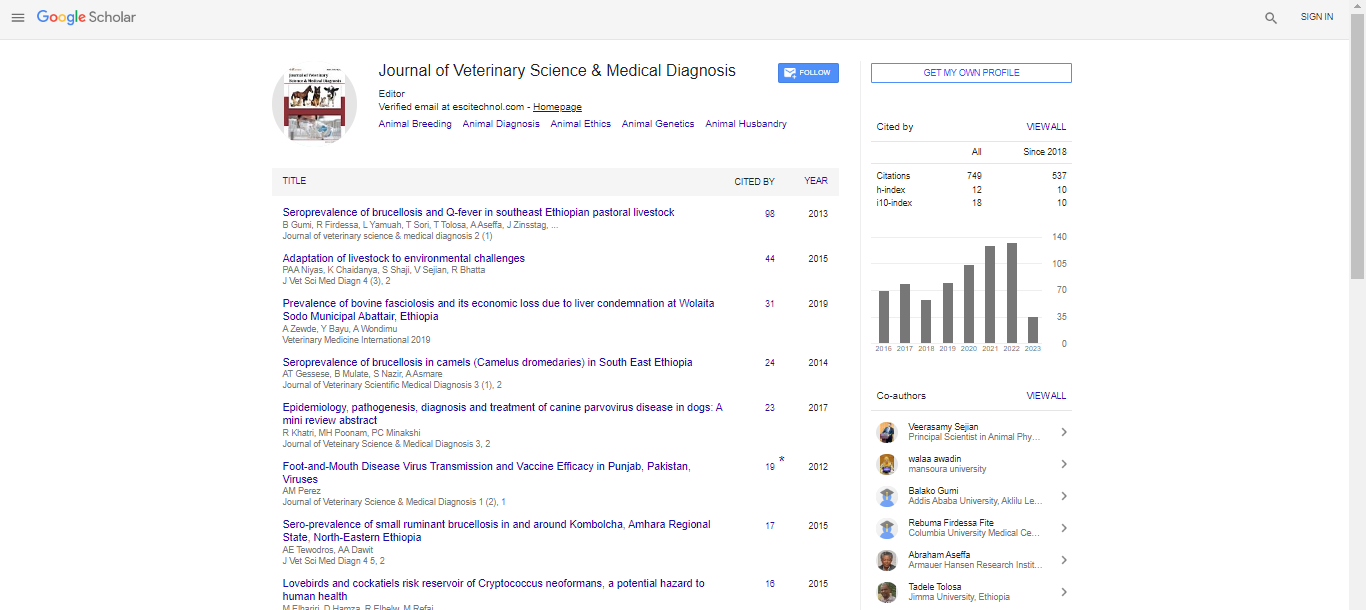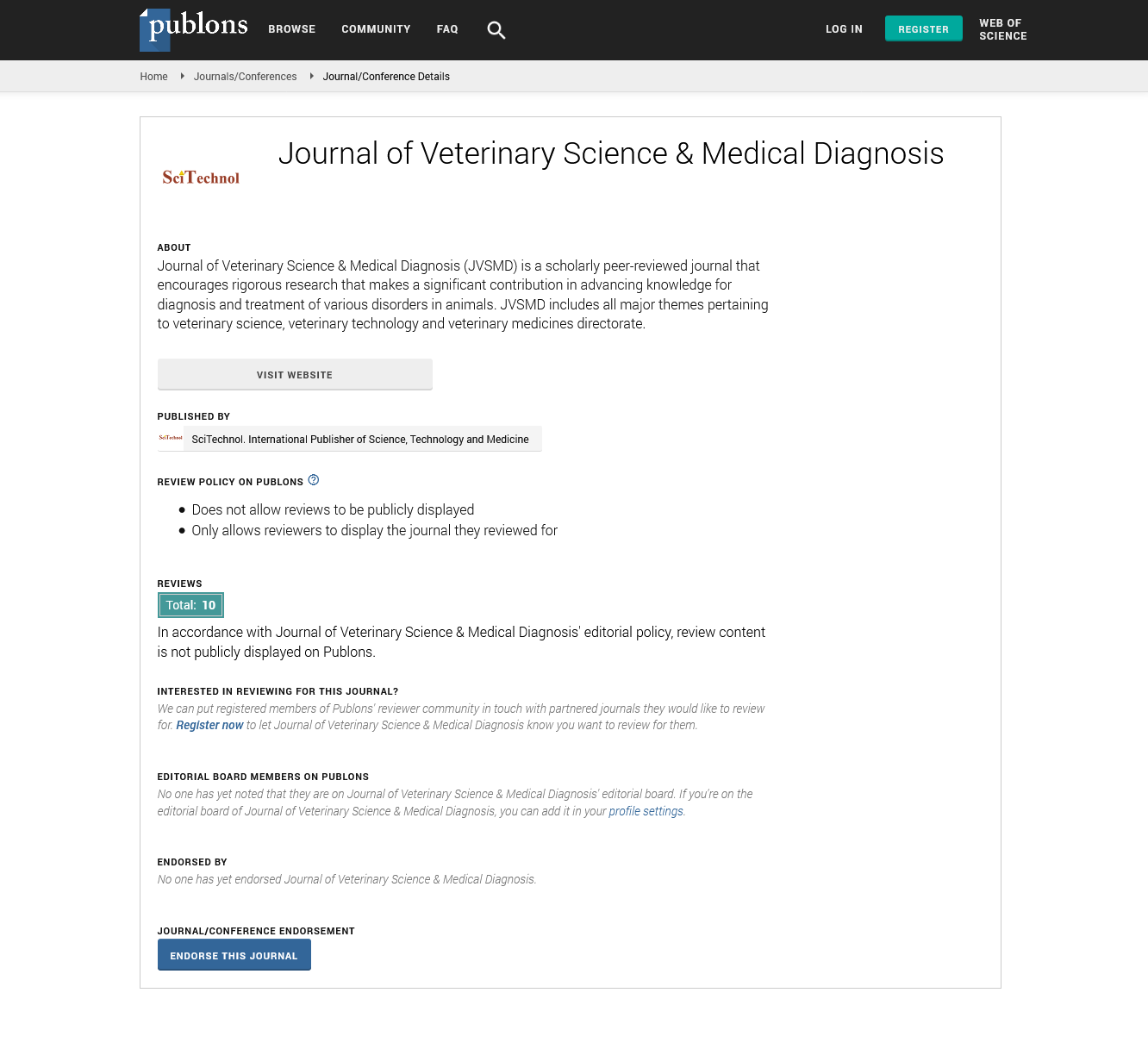Commentary, J Vet Sci Med Diagn Vol: 12 Issue: 4
Etiology, Transmission and Clinical Manifestations of Trichomoniasis in Animals
Valentina Ferrante*
1Department of Veterinary Pathology, University of Teramo, Teramo, Italy
*Corresponding Author: Valentina Ferrante,
Department of Veterinary Pathology,
University of Teramo, Teramo, Italy
E-mail: valen@vetdgn.it
Received date: 26 Jun, 2023, Manuscript No. JVSMD-23-111789;
Editor assigned date: 30 Jun, 2023, Pre QC No. JVSMD-23-111789 (PQ);
Reviewed date: 14 Jul, 2023, QC No. JVSMD-23-111789;
Revised date: 21 Jul, 2023, Manuscript No: JVSMD-23-111789 (R);
Published date: 28 Jul, 2023, DOI: 10.35248/2325-9590.23.12.1000064
Citation: Ferrante V (2023) Etiology, Transmission and Clinical Manifestations of Trichomoniasis in Animals. J Vet Sci Med Diagn 12:4.
Description
Trichomoniasis is a disease caused by the protozoan parasite Trichomonas, is a notable challenge that affects various animal species worldwide. While often associated with human infections, this parasitic disease poses significant threats to the health and well-being of livestock, pets, and wildlife. Trichomoniasis is primarily caused by the protozoan parasites belonging to the Trichomonas genus. These single-celled organisms exhibit remarkable diversity, infecting various body systems in animals. The most common species implicated in animal trichomoniasis include Trichomonas foetus, Trichomonas gallinae, and Trichomonas vaginalis. Each species exhibits unique host preferences and pathogenic behaviors, underscoring the complexity of this parasitic infection. Trichomoniasis in animals follows intricate transmission pathways, often influenced by speciesspecific behaviors and environmental factors. In livestock, such as cattle the infection is often sexually transmitted, resulting in reproductive losses, decreased fertility rates, and prolonged calving seasons. Similarly, in avian populations, the spread of Trichomonas gallinae occurs through contaminated water and feed, affecting birds' oral and digestive tracts. In domestic pets, particularly cats, trichomoniasis primarily affects the gastrointestinal system, leading to chronic diarrhea and associated complications.
The clinical manifestations of trichomoniasis in animals are diverse and multifaceted. In cattle, Trichomonas foetus infections result in infertility, early embryonic death, and extended calving intervals, which can lead to substantial economic losses for cattle industries. In avian species, oral trichomoniasis in birds like pigeons and raptors leads to the development of yellowish plaques in the oral cavity, affecting feeding and causing weight loss. Domestic cats affected by trichomoniasis exhibit chronic large bowel diarrhea, which can be challenging to manage and may result in weight loss, dehydration, and discomfort.
The economic implications of trichomoniasis in animals are farreaching. In livestock industries, such as cattle and poultry farming, the disease can lead to reduced productivity, compromised reproductive efficiency, and increased veterinary costs. Furthermore, in wildlife populations, trichomoniasis can significantly impact ecosystems by influencing population dynamics and potentially contributing to declines in vulnerable species. For example, trichomoniasis has been associated with declines in certain bird species, disrupting food chains and ecological balance.
Efforts to prevent and manage trichomoniasis in animals necessitate a holistic approach that considers the diverse species affected and the various transmission routes. Implementing biosecurity measures is important which includes quarantining new animals, maintaining proper hygiene, and restricting movement between populations. In livestock, regular veterinary screenings and culling of infected animals are essential for disease control. For pets, early diagnosis through laboratory testing and proper treatment under veterinary guidance is crucial.
Ongoing research on trichomoniasis is important for advancing our understanding on the disease's epidemiology, pathogenesis, and potential treatment options. Advancements in diagnostic techniques, such as molecular assays, have enabled more accurate and timely identification of infections. Additionally, the exploration of alternative treatments, such as probiotics and immune-stimulating agents, holds promise for mitigating the impact of trichomoniasis in animals. Raising public awareness about trichomoniasis is important for promoting responsible animal ownership practices and encouraging proactive disease management. Livestock producers, pet owners, and wildlife enthusiasts should be educated about the signs, transmission routes, and preventive measures associated with trichomoniasis. Public engagement can increase collaborations between veterinary professionals, researchers, and the general public, facilitating a collective effort to combat this parasitic infection.
 Spanish
Spanish  Chinese
Chinese  Russian
Russian  German
German  French
French  Japanese
Japanese  Portuguese
Portuguese  Hindi
Hindi 
